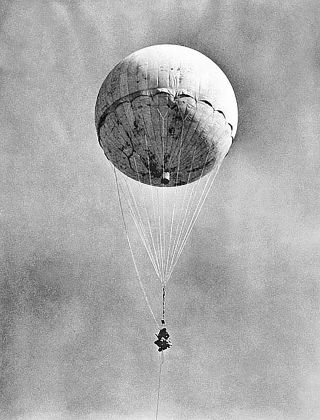Resilience
Balloons in the Sky Offer a History Lesson
Recent sightings recall one of the best-kept secrets of World War II.
Posted March 3, 2023 Reviewed by Tyler Woods
Key points
- Keeping balloon sightings a secret helped turn the tide in World War II.
- Anxiety about what's in the skies above is not new.
- A history lesson may help us deal with recent balloon sightings.
In the waning months of World War II, the Japanese military looked to the heavens as a way to strike back against its pending defeat. In a last-gasp measure, they sent thousands of paper balloons, about 30 feet in diameter, aloft to drift toward our shores.

These curious yet dangerous weapons were armed with incendiary devices, rigged to explode upon impact or after three to four days had elapsed. The fire balloons were designed to be carried eastward in the jet stream across the Pacific Ocean.
From early November 1944 until the spring of the following year, approximately 9,000 fire balloons were launched from various sites in Japan. Nearly 300 of these devices detonated in North America, ranging from Alaska to Mexico. Most of the incidents took place in the western states, an effort to spark forest fires, but one was later reported to have set down about 150 miles west of Detroit.
You won’t find much mention of the Japanese fire balloons in history books and the official record. Why? The U.S. government did its best to keep them secret. And what may seem surprising in our days of blogs, podcasts, and 24/7 news churn: such measures mostly succeeded.
Behind the scenes, the “Sunset Project” deployed radar sites in the state of Washington to attempt to locate the fire balloons in flight. Meanwhile, the Department of Agriculture informed local veterinarians and 4-H club officers about the potential threat and asked them to keep an eye out for any strange activity or condition with livestock or crops. (According to historian Robert Mikesh, the U.S. War Department soon realized that the balloons might be able to transport nerve gas or other chemical agents.) In addition, the Air Force in San Francisco began to patrol the skies along the west coast for these balloons.
Such campaigns had little success, though, as locating and destroying small objects in the skies and even after they had landed was akin to searching for a needle in a haystack. That’s what makes this past eerily similar to recent headlines about Chinese spy balloons and more primitive devices. What is up there, exactly? What are we up against?
Early in 1945, The Office of Censorship requested that U.S. newspapers and radio not report anything about balloon incidents. To a large extent, the media held to such suggestions.
Now, I’m not a proponent of news blackouts and censorship. Yet in the curious case of the Japanese fire balloons, without holding information from the public until we knew what we were up against made a difference.
At the time, the Japanese were monitoring our news reports. Despite their weapons being made of paper, they were pushing the envelope when it came to armaments and tactics for the day. Could balloons made of paper, stitched together by women and girls in Japan, be sturdy enough to survive a three-day passage across the Pacific? (They could.) And how about the power of the jet stream? Was it strong enough to carry a craft with no control, borne along by the wind, all the way to North America?
Again, their calculations were correct, as one balloon bomb ignited brush fires near Hanford, Washington, the site of an atomic energy plant. In a tragic incident, a family of six was killed when a fire balloon exploded near Bly, Oregon. Today, a bronze plaque at the site reads, “The only place on the American continent where death resulted from enemy action during World War II.”
Through it all, the Japanese military had little idea of how effective their campaign was or could have been. When they heard nothing to affirm their projections, they eventually stopped the fire balloons on their own. It helped that U.S. air raids against Japan made the necessary raw resources scarce. The fire balloons were stopped even as equipping them with biological agents, instead of rudimentary fire bombs, was becoming possible.
“Japan was kept in the dark about the fate of the fantastic balloon bombs because Americans proved during the war they could keep their mouths shut,” stated a U.S. military release published in the New York Times two years after World War II ended. “To their silence is credited the failure of the enemy’s campaign.”
A writer in residence at Johns Hopkins University, Tim Wendel is the author of several books, including Red Rain, a novel about the Japanese fire balloons.


